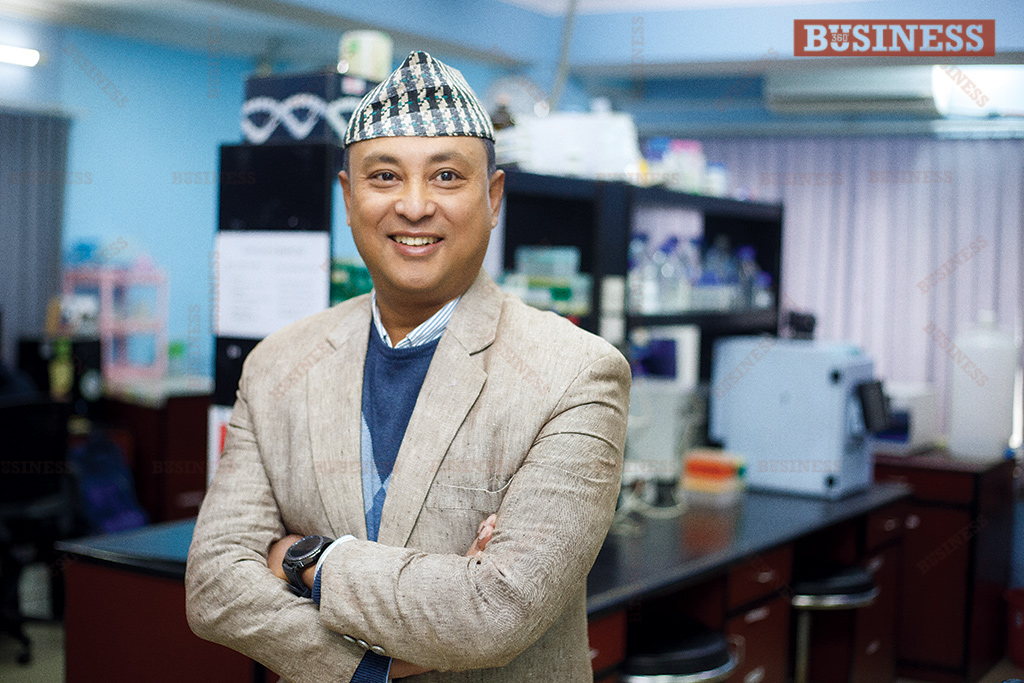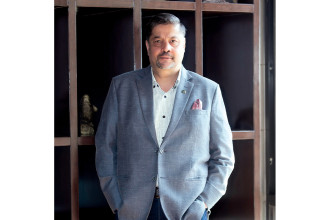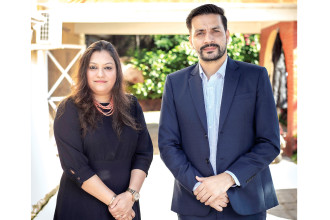
Dibesh Karmacharya is the Chairman and CEO of Biovac Nepal. He has a Conservation Biology degree from Wayne State College, USA and a PhD in Conservation and Microbiome Genetics from Griffith University, Australia.
Karmacharya worked extensively in the US for Caliper Life Sciences in New Jersey as a Research Scientist (transgenic animal models) for three years and promoted Genomics and Proteomics technology platforms for GE Healthcare Life sciences in the US and Canada for eight years.
Karmacharya is the Founder, Chairman and Executive Director of Center for Molecular Dynamics Nepal (CMDN), wildlife genetics and clinical epidemiology research centre. He also founded Intrepid Nepal, a molecular diagnostics based biotechnology company, and Intrepid Cancer Diagnostics, a leading cancer diagnostic laboratory.
He has led several innovative researches in Nepal including building Nepal’s first genetic database of wild tigers through Nepal Tiger Genome Project and is the Principal Investigator of PREDICT Nepal, an emerging pandemic threat project. He is also the Co-Founder of Naagiko Honey.
Dibesh Dangol of B360 interviewed Karmacharya to get his views on the prospects and challenges of different farming sectors and establishment of biotechnology and clinical epidemiology companies, the role of government agencies to develop the agriculture industry and the work Biovac is doing to divert the import costs of vaccines and other medicines. Excerpts:
What are you currently working on?
In the last 12 years, we have set up a lot of our efforts in research. We are a company that believes in innovation and we have been innovating new technologies to find more information on heath. In health, there is a concept called One Health. 70% of human diseases are coming from animals. So, we must understand diseases from a holistic approach. The concept of One Health comprises human, animal and environment health. So our capacity in terms of detecting, characterising and understanding the diseases from One Health perspective is unique in South Asia.
Our lab is only a handful of labs in South Asia that looks after all these three different aspects of One Health. Understanding the importance of prevention we have recently started to get into vaccines. Vaccine research and development in Nepal is still in its infancy which is why we wanted to build the capacity first. We are focused on research because it is where our core competency is with CMDN or biotech; we then use the innovative stuff that we have been doing in vaccine production. Now we have a real state-of-the-art facility at Nala. Back in 2007, we started the whole thing with $250,000, five investors and seven employees. Now we have six different labs, close to 100 people and our spectrum of engagement is broad which covers health and environment.
What inspired you to get into the field of clinical epidemiology and wildlife genetic research?
I got into clinical epidemiology because I wanted to come back here and start something innovative. I wanted to see where the biggest gap is and found out that many people aren’t aware of a lot of infectious diseases, their burden and scopes. So, I thought this is an area where I can focus and also bring my biotechnology expertise and close that gap. That was the whole idea behind me getting into clinical epidemiology, epidemiology research or disease research.
In terms of wildlife genetics, that’s where my passion lies. I have always been keen on tigers and wildlife all my life. I did my PhD on tiger genetics and we have done some outstanding works here on tigers including some of the firsts in the world like tiger gut microbiome study. The study isn’t just the first study done on tiger’s gut microbiome but also is the first done on large carnivore animals. I am also fond of going out in nature and have done a lot of work on snow leopards and other endangered species. Biodiversity is something that I love and want to work to preserve.
What were the challenges you had to face initially in Nepal?
Nepal presents itself as a unique opportunity for the things that you can or want to do. It is unique because in the two spaces that we are involved in i.e. health and biodiversity, Nepal is very rich in diseases and biodiversity as well. Access to information regarding these are abundant. At the same time, Nepal is also a difficult place to work because the policies are not clear and a lot of the other critical resources in these areas aren’t simply there. Being a pioneer, it certainly poses a lot of challenges. Therefore, when we named our company, we named it Intrepid because it means going to places that no one has gone before. So yes, there are many challenges.
Challenges come from lack of infrastructure and services like utilities. These add up to the company’s overheads which makes us less competitive on a global scale. But, at the same time if people know how to do it and if they have strong determination to do it, there are ways to navigate through the system, and people can build that ecosystem. Once people build it, they can enjoy getting access to other assets. Also, there are a lot of challenges in terms of human resources. We don’t have properly trained human resource. Our academic institutions aren’t well structured nor have the capacity or infrastructure to train students regarding new technologies that are required for industries like ours which works on cutting edge technologies and innovation. However on a positive note, if we can build training facilities, access to the human resource here is tremendous. There is a very talented pool of youths in Nepal and if we can make them dream and train them properly, it will be easy to get the best human resources. So, there are challenges as well as opportunities here in Nepal.
Nepal is known as an agricultural country. Has the right intervention been taken by the government regarding this?
Although we say the majority of Nepal’s activities are involved in agriculture, there are many gaps in our agricultural landscape. We aren’t producing as much as we can. Our value chain is very fragmented meaning a producer isn’t able to access the proper market. There is inefficiency in terms of production and sales. The farmers aren’t getting maximum results out of their production. There is a lack of national strong policies and programmes. Irrigation in most of our hilly regions is a problem.
Transportation is a big problem as we don’t have proper roads and infrastructure to take the products from one area to another. Simple things like storage is also a problem. Therefore the assets like a really good agricultural land and climate isn’t being utilised to its maximum capacity. If major areas like education, training, access to finance, value chain and markets are improved, agriculture can take a leap in Nepal.
Our policies aren’t well defined and because of such issues, there aren’t clear instructions to people who are involved in this industry. There is a lack of standardisation and implementation of policies like monitoring, evaluation and implementation. We also don’t have an innovative culture and consider ourselves good at copying. There has to be a clear understanding between producers and consumers, policymakers and implementers. Unless and until there aren’t really good dialogues happening between all of them and government agencies coming up with right policies beneficial for both consumers and producers, we will never be able to rule out the problems or effectively facilitate our industries. The policymakers, the producers and the consumers are disconnected right now. There has to be a degree of partnership, probably on a public-private partnership level. The government needs to be a facilitator, an enforcer of the policies and implementer of industries. So, until and unless these things are settled, we will keep running into problems.
Your comments on poultry farmers dealing with seasonal diseases like bird flu in Nepal. How is Biovac involved in spreading awareness and vaccines?
Poultry farming is a growing business. In Nepal, it captures 4% of the total GDP. Backyard poultry farming is a lot bigger than commercial poultry farming in Nepal covering 60% of total poultry production. Backyard poultry is playing a very important role in rural communities because it is not only a source of protein for them, but it is also a source of livelihood. Therefore, it plays a big role in the overall economy and also at the household level in rural communities which I don’t think is being calculated properly yet. As important as this industry is, going back to my previous comment about not being able to maximise product efficiency, it creates a lot of problems.
To give a comparison, if a Brazilian farmer keeps a hundred chickens and a Nepali farmer keeps the same number of chickens, the Brazilian farmer can raise a hundred chickens properly and raise money from 90% of them whereas the result for Nepali chicken production will come around 50-60% only. There is this huge inefficiency that’s in-built. One of the reasons for the inefficiency in the production or low production is because of preventable diseases. For example, Newcastle disease is caused by a virus and if farmers don’t take care of it through vaccination it reduces the production by 25% which is a huge number just because of one disease. If you throw in Avian Influenza or Bird Flu, it has negative implications not just in terms of poultry production but human health as well. So, if farmers find out the disease is Bird Flu, the farmer loses all the birds which means economic loss and potential danger for their health as well. All of these diseases aren’t well understood and often neglected and because of that our production is not as high as it should be.
We decided to focus on Newcastle disease because it impacted 25% of poultry production and we wanted to produce the vaccines that are going to prevent it. However, there is a general lack of information about the diseases. With strong research, we have figured out how big of a problem Newcastle disease is nationwide. We went to different farms all over the country, both commercial and backyard, and also wild birds as well. We screened for Newcastle disease and other viruses. Through the research, we got a clear picture of the burden of Newcastle and Bird Flu viruses. We were astounded to see these numbers. 83% of Nepali chickens have antibodies against Newcastle which means that they are either exposed to the disease or vaccines, and Bird Flu was about 40%. In terms of Bird Flu, we don’t vaccinate the chickens, but we still saw 40% of the chickens having the antibodies. This means the exposure to the diseases is pretty high and so we need to intervene accordingly otherwise we will not be able to stamp out the outbreak of diseases. We have invested a lot of money on fact finding first before we start the use of vaccines against the diseases.
Total eradication is what everybody wants but isn’t achievable. An interesting thing is that Newcastle disease is caused by a premix virus and it has different strains. Some cause chickens to die whereas some don’t. Nepal is one of those countries where Newcastle disease has been here for a long time. Some of these strains don’t kill the chickens and our backyard and local chickens are very resilient to this disease having developed immunity power against it. So those strains of the Newcastle virus that don’t cause the disease can be used as a vaccine target. We have found two strains in Nepal that are called lentogenic meaning that these strains don’t kill the animals and build their immunity. These strains can be used as a vaccine strain which we can develop and patent. Vaccination is the best way to mitigate the problem. We won’t be able to completely eradicate but we can manage it in a certain way that the mortality from the diseases to the chickens can be less than 5%.
Nepal has been importing poultry vaccines and other vaccines for a long time; Is this the gap Biovac wants to close?
Biovac is not just about vaccines. Biovac has a wide range of products and services including vaccines that are designed to lower the disease burden. We are working on the diagnostic approach as well. We have made a handheld device that can detect the viruses out in the field which is very important. We have also set up a mobile veterinarian team that can go and advise farmers. Then there are vaccines. Our vaccine which is based on I-2 strain from Australia is thermal stable meaning the vaccine will remain stable even in room temperature. The vaccines that are currently imported from other places need cold chains like refrigerators or freezers. If people don’t have these storage facilities, they can’t use the vaccines.
As I mentioned before, 60% of Nepali poultry production comes from backyard chickens. So, until and unless the vaccines reach the villages that have 20-30 chickens, the problem can’t be solved. With the currently available vaccines that are being imported from outside, the problem will not be solved because of cold storage limitations. Here we are doing two different things with our vaccine products: we are trying to be very competitive against the imported vaccines by focusing on our effectiveness to come up with the whole chain that requires vaccine products and we have invested a lot in terms of catering to the backyard chicken poultry farmers.
Everyone will have access to vaccines that can be used easily without the support of veterinaries and even if farmers need veterinary help, we can provide them with that. We have also found that just vaccines aren’t going to be effective. There needs to be strong bio-security as well. Our team of mobile veterinaries can provide advice on bio-security to the farms as well. We are building a mobile app through which they can directly contact and interact with us so that we provide them with complete solutions to poultry health. We can tell the farmers if their farm setup is good or not, we can do routine screening for the viruses or diseases floating around, we can also schedule them with preventive vaccine schedules and help them come up with the right formula so that you can have a one-stop solution for your animal health.
Right now, we are in the first phase and are concentrating on Newcastle vaccine. Once we have completely built our facility, the plan in the next four years is to produce 8-10 different vaccines including vaccines against rabies and other diseases.
We work closely with the Department of Livestock Services and other stakeholders like poultry farmers. With government agencies like the Department of Livestock Services, we share information on what we have found on Newcastle and Influenza nationally through our studies. We have plans to collaborate with Nepali government agencies. Our collaboration goes beyond Nepal as we have been collaborating with leading institutions of the US, Europe and Australia to come up with more effective vaccines. Eventually, our goal is to export these vaccines to Africa, South East Asia and South Asia.
What contribution do research centres like Centre for Molecular Dynamics Nepal, Intrepid Nepal and Biovac Nepal play in terms of introducing newer technologies in agricultural and poultry farming to gain maximum outcome?
Biotechnology in particular and innovative solutions in general that we are focused on does these things for agriculture. Firstly, it helps us understand the landscape of our agricultural status whether it’s crop production or animal production. We are big into the geographic information system (GIS) and landscape-level of mapping. We have developed interactive vegetable maps where we know the farmers who are growing and the consumers who are going to buy. There is a disconnect between producers and consumers and our platform using mobile technologies and other technologies to bring them together for which we have invested a lot of our time and effort. Understanding where things are at is the key.
Second is to train human resources to know which crops or animals will be more valuable to us. We are also working with the Nepal Agricultural Research Council (NARC) in terms of finding out drought and disease-resistant crops. For this, we are doing research and finding out genetic viability for our landscape, topography, weather, etc so we can know which crops can be the best for our country.
Third is understanding diseases or particularly health in animals and plants. There is still an invasion of fall armyworm that eats up agricultural products on a massive scale. We were able to detect it by using DNA technology and give that information to the government.
Overall, on the value chain, we are also being able to work with communities and provide information to federal, provincial and local governments to stir up conversations about how to do these things better from an entrepreneurial perspective and how doing such is going to be beneficial to the communities. I focus a lot on rural communities. For example, in Makwanpur, Chepangs eat bats which are known to harbour viruses like ebola. We ended up studying there for four years regarding viruses in bats, humans and the environment. While I was there, I also got to taste the local Chure honey and it’s fantastic. They produce a lot in that particular area, close to 30-60 tons every season. But the problem is that they don’t know how to market that honey although the honey is wonderful. So, we ended up setting a company called Naagiko Honey and that honey and company are taking social entrepreneurship to a different level directly benefiting the communities. From research side, we can translate that into some of the developmental projects that translate into direct benefits to communities on grassroots level.
In a value chain, everyone is important and everyone has their part to play. Just because there are direct connections between farmers and consumers doesn’t mean that the role of the middle people that work on a value chain handling logistics isn’t just going to go away. We believe in fair trade and if someone is producing a product, they should be duly rewarded for their production. What’s happening right now is that there are middlemen between the producers and the consumers and they are taking a major portion of profits and farmers are not getting any money. The main question is how to balance that out. It can be balanced out if there is a free flow of information. If the farmer knows that there is a competitive market where their products will be valued more, they will go there and not have to be dictated by the middlemen although middlemen still might play a role. If that flow of information is readily available, then middlemen might be interested in making more money because they will think of their survival as well. That’s how I think the dynamic is going to change with the free flow of information.
Why has Nepal not been able to become self-sustainable and what is stopping farmers from adopting new technology to improve and increase productivity?
I think a few things are hugely lacking in this country. The government should be designing policies from federal, provincial and local levels to benefit the producers. Taxation on farming tools and products is very high. There is a lack of infrastructure like roads and electricity resulting in high cost of production. Those are the things that are hugely lacking. We need to start thinking of prioritisation of industries like whether producing rice is going to be as beneficial or profitable or something else. That kind of comparative assessment is still not being done. The irony of all these cultures is that we have to import products that we can produce adequately like onions, vegetables and flowers. Most of the produce are being imported whereas the domestic products are getting rotten because of lack of market knowledge, storage facilities, etc. So, these are some of the deep systemic problems.
But, then there are some problems due to the lack of entrepreneurship culture in Nepal. The domestic uses are one thing but there aren’t many entrepreneurs that are keen on finding out what can be exported outside. Poultry, for example, feeds are very expensive because most of the important ingredients like soybeans are being imported from other countries. So, if you have 4% of GDP in the poultry industry and one of the main ingredients for that industry has to be imported, the question is why aren’t we producing that ingredient domestically which can be easily done. Those are the things that need to be worked out. Topographically, we have diverse land and like any other industry, agriculture can also be specified in terms of what can or would be the best like ginger in the hills, rice in Terai and citrus fruits in the Himalayan regions. This prioritisation needs to be there along with determining the market for the sale of those productions. So, entrepreneurial business sense hasn’t been properly realised.
There isn’t any other profession that’s more important than being a farmer. As long as a society, government and individuals don’t recognise this it will never be looked upon very favourably. That’s from a philosophical and psychological level. Secondly, it’s about education and training. Most of the people involved in farming don’t have a high school degree. Farming is looked upon as a profession that is done by someone who is not well educated or from a good family background. This needs to change. The third is economic sense. If you don’t get the message out saying that the next big challenge will be food and water in the future and farming is the best profession to be in especially in Nepal given the availability of fertile land and other resources, the sector will go nowhere. If that’s not being understood, we will never reach there. So economically, it plays a major role. If people have an understanding regarding these situations and the importance of farming from an economic point of view, there will not be changes at all in this profession.
There have to be champions and farming heroes need to be recognised to uplift the involvement in farming. I am involved in farming and agriculture also. It is not because I have a social angle to it but because that’s where the prospects are in the future. Food and water are going to be a problem in the future and therefore that’s where the opportunities are. If you see a value in it, you’ll get into it. To show the value, that’s where the role of the government by introducing the right policies and incentives. Unless such messages aren’t spread out we won’t be able to light the fire saying farming is the best thing that we can do. We can’t always import. We export $6 billion a year and then we import $12 billion worth of goods from other countries. What are we producing? We are producing nothing. How can our economy work when we are depending on exporting labour to other countries? It doesn’t work. These need to be changed and an economic environment needs to be created. It’s just not the role of the government.
The government will and can do only certain things. It is also the role of citizens. All kinds of development works that are happening in Nepal are driven by the private sector and the private sector needs to seriously consider this issue as well. Also in a democratic country like Nepal, democracy and voting rights need to be focused on the issues that have to do with agriculture as the majority of our population is depending on it. It’s complicated but possible.
Biovac was able to attract one million Euros in investment from three investors. Can you tell us about it?
We were able to attract the investment by selling the idea that this is a good project to invest in and by making our investors understand the supply and demand part of it. We had discussions with people and stakeholders who care about development in Nepal and presented them the implications of this project not just in Nepal but also in developing countries similar to Nepal like those in Africa. We also told our investors and sold the idea that this problem is not just specific to Nepal but is also a global problem.
Why would someone invest in projects like this? They invested because they can relate to it. This is also a project that is designed to achieve a lot more than just the production of vaccines. This is a project designed to lift things from the ground up. It has social entrepreneurship and innovation. Therefore, we just didn’t get one million dollars in investment, we also got an additional half a million dollars from the Australian government to innovate more. Different innovations can be used all over the world. I think that’s how we were able to attract different grants and investments.
We have three different phases. The first one is building the capacity to make vaccines, to do research, develop and manufacture them. The second part is to expand into other diseases as well. The third is to engage international stakeholders, experts and communities to work closely with us so that we can develop vaccines here and export it outside. Those are the different things we have done with the funds which we were able to attract in Biovac.
Biovac, the way it is structured, not only has a 360 degree angle in terms of product and services but also has broadness as a company and facilities. We have built this from ground up and in a record amount of time as well. Usually, the average cost of making a vaccine company is about five million dollars and the average time of setting up is three years. We made this in 1/5th of the cost in half the time. So, it can also be taken as an example to do somewhere else where there are similar problems like in African, South Asia or South East Asia countries. It’s not the vaccines we are trying to sell; we want to sell everything that has to do with vaccine research, development and manufacturing including building a plant. We have a master plan on how this can be made cheaper and better.
Scaling up is our plan. Our facility is an ideal R&D lab. It has the production capacity of about 20-30 million per year of one product. Our aim now is to scale it up. In 4-5 years we want to have ten different kinds of vaccines that will play a significant role in minimising or mitigating all prevalent diseases in poultry and livestock.






